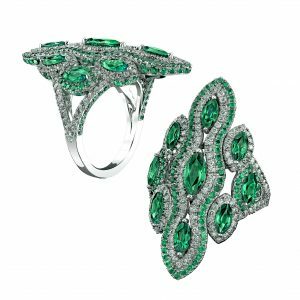Caring for your Jewellery while abroad
Heading to the Mediterranean this season? While you soak up the sun, make sure your diamonds are just as radiant when...
In this post, we’ll discuss the four different types of emeralds to consider for your next emerald jewellery set.

When it comes to emeralds for jewellery, there are four main types: Colombian, Brazilian, Zambian, and synthetic emeralds. These types are divided based on where the emerald originated from, and each has distinctive characteristics.
Colombian emeralds are known for their intense green colour and exceptional clarity. They are widely considered the most valuable and sought-after type of emerald, and are primarily found in mines located in the Muzo and Chivor regions of Colombia.
Brazilian emeralds are known for their slightly darker green hue and lower clarity compared to Colombian emeralds. They are still highly valued, however, and can be found in several regions throughout Brazil, including Bahia and Minas Gerais.
Zambian emeralds are relatively new to the market but have quickly gained popularity for their deep green colour and excellent transparency. They are typically more affordable than Colombian emeralds, but still highly valued for their unique colour and quality.
Synthetic emeralds are created in laboratories and designed to have the same chemical and physical properties as natural emeralds.
While they may not have the same allure as natural emeralds, synthetic emeralds are a more affordable alternative. Your jewellery can still have the elegance of an emerald without the steep price tag that comes with them.
This May birthstone has a rich history that dates back thousands of years. The earliest known emerald mines were located in Egypt, with evidence of mining dating back to 330 B.C.E. The ancient Greeks and Romans prized emeralds, associating them with the goddess Venus and Aphrodite and the power of rebirth.
Geologically, emeralds are a type of beryl mineral and are formed deep within the Earth’s crust. They typically form in areas with high pressure and high temperature, near fault zones or in pegmatite veins. Some of the most significant emerald deposits are found in Colombia, which has been a major source of the precious gemstone.
How much emeralds are worth depends on the size, colour, clarity, cut, and origin.
Colombian emeralds are considered the most valuable in the world due to their distinctive green colour, exceptional clarity, and rarity. They command premium prices in the market, ranging from $10,000 to $50,000 per carat. Some emeralds from Brazil, Zambia, and Madagascar, are highly valued for their unique colour and quality.
When it comes to emeralds, both light and dark stones can be beautiful and valuable. The preference for a particular shade of emerald is a matter of personal taste.
Lighter emeralds, sometimes referred to as “mint” or “spring” green, have more yellow tones and a delicate and fresh appearance. This colour of emerald is more common than those with darker or bluer tones. They tend to be more affordable for this reason.
In contrast, darker emeralds have a deeper, richer green hue. They can be extremely valuable depending on their clarity and cut. These types of emeralds are commonly found in Colombia.
There are several ways to determine the authenticity of an emerald:
Natural emeralds often have inclusions or imperfections within the stone, such as tiny gas bubbles or mineral crystals. However, synthetic or lab-grown emeralds look nearly perfect in appearance. You can use a jeweller’s microscope to spot inclusions.
Emeralds typically have a deep green colour, but they should not be too dark or too light. If the colour seems too vibrant or pale, it may be a sign that the stone is synthetic.
Emeralds are denser than most other gemstones, so they’ll sink in water. If the stone floats, it’s likely fake.
If you have doubts about the authenticity of your emerald, consider having it certified by a reputable gemological laboratory.
From Colombian to synthetic, each variety of emerald offers something unique when it comes to jewellery. But finding an emerald with your desired size, colour, clarity, and cut can be challenging.
However, by following the tips above, you can purchase a beautiful and high-quality emerald that will be a treasured addition to your jewellery collection.
Heading to the Mediterranean this season? While you soak up the sun, make sure your diamonds are just as radiant when...
When it comes to purchasing an engagement ring, the diamond isn’t the only star of the show. The setting style can...
Investing in gold jewellery is a time-honoured tradition that continues to shine in 2025. Gold has been a reliable...